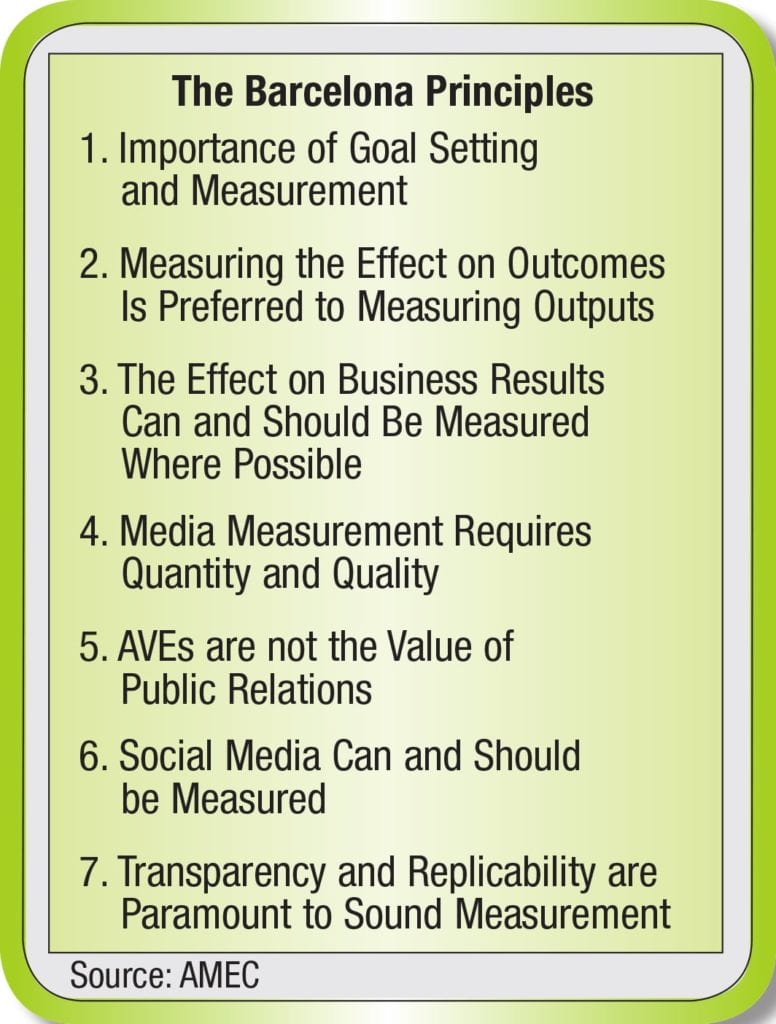 The Barcelona Principles, the declaration of standards and practices to guide the measurement and evaluation of public relations, is about to mark its fourth anniversary.
The Barcelona Principles, the declaration of standards and practices to guide the measurement and evaluation of public relations, is about to mark its fourth anniversary.
But don’t expect too much celebrating. Nearly four years after being introduced, the principles serve as a blueprint for PR professionals and communicators looking to legitimize their measurement efforts. And yet, not much has happened in terms of widespread adoption. It’s been a long, hard slog.
Truth is, there’s still a lot of work to be done in educating communicators about the principles and in convincing brands and organizations to adopt new standards stemming from the document.
“We needed a few years for everyone to wake up to the fact that it would be helpful if all of us spoke the same language,” said Linda Rutherford, VP of communications and outreach at Southwest Airlines. “We are now heading in that direction.”
Southwest Airlines, General Electric Co., General Motors Corp. and McDonald’s last October adopted the first round of standards proposed by the Coalition for Public Relations Research Standards, which was formed in 2012.
The coalition’s participating organizations are a veritable alphabet soup of PR: the Public Relations Society of America (PRSA), the International Association for the Measurement and Evaluation of Communication (AMEC), the Institute for Public Relations (IPR), the Global Alliance for Public Relations and Communication Management, the Council of Public Relations Firms and The Conclave, a groups of social media specialists.
The first set of adopted standards covers traditional media measurement, digital and social media measurement, communications lifecycle (awareness, knowledge, intent, preference, and advocacy) and return on investment. (For details on the standards, go to www.instituteforpr.org.)
For the last several months, the “core four” brands have been working with their in-house measurement executives and vendors on how to put the initial standards to use.
“We’re applying the interim standards and trying them on for size,” Rutherford said. “It’ll be a game changer if we’re all speaking the same language, showing how we define success and how we measure it.”
SPREAD THE MESSAGE
But there’s a growing sentiment that the PR practice needs to do a much better job of educating communicators (of all stripes) about the Barcelona Principles as well as the initial set of standards.
A recent survey by PR News found that 66% of PR professionals are not familiar with the Barcelona Principles. The survey drew 145 responses.
“We need improvement on the awareness of the standards,” said Frank Ovaitt, president-CEO of the IPR. “We need to get out there and promote more standards in PR measurement, which is not an easy story to tell. We’re winning the war even if some battles will require more firepower.”
Giselle Bodie, CEO of the measurement company Salience Insight, added: “We have clear evidence that PR measurement is growing and in good health. However while it is pleasing for the industry that, slowly but surely, it is establishing a foothold in the wider PR and marketing consciousness, we are still a ‘work in progress.’”
One test will be later this year, when the coalition is hoping to achieve widespread adoption of the initial measurement standards.
Rutherford stressed that it will be a challenge to get measurement vendors on board, many of which have a vested interest in maintaining their own measurement tools.
“We need to foster competition on the [communications] insights, not on the black boxes,” she said. “The pressure needs to come from the client.”
PR Measurement standards will evolve, of course, to conform to macro changes in the marketplace. However, regardless of the nuts-and bolts, communicators need to put the concept of measurement at the forefront of all their activities, said Molly McKenna Jandrain, director of PR at McDonald’s (USA).
“The big difference is we used to measure the results in terms of outputs,” she said. “Now, we’re using measurement to inform strategy and allow us to measure outputs as they relate to business outcomes.”
Asked about the low visibility of the Barcelona Principles, McKenna Jandrain said: “It shows we have more work to do. If we want to elevate the PR profession, we have to take the standards seriously.”
Barcelona Principles Facing Growing Pains

The president of a mid-sized PR agency once confessed to me: “I’d rather forego being a proven success in exchange for never being a proven failure.” This attitude undermines public relations’ aspiration for professional status and misses two of the greatest benefits of research: to provide the feedback required to make better decisions in the future; and to provide validated “proof of performance.”
In 2010, the Barcelona Principles established straightforward guidelines for proving and improving PR performance. But after four years, public relations practitioners have not widely adopted the principles, leading PR research advocates to consider what must be done to take the profession forward on this important matter. Here are a few my observations and suggestions on why the Barcelona Principles have not achieved broad acceptance and what can be done now to improve adoption.
• Observation: Like it or not, public relations is not acculturated to measurement.
• Suggestion: The “measurati” must continue to reinforce the importance of measurement as a long-term goal rather than seeking instant results. Last year, GM, GE, MacDonald’s and Southwest Airlines publicly endorsed the standards. Now, measurement advocates, as well as the four companies themselves, must reinforce the wisdom of their decision and enlist many more organizations to follow suit (though wide acceptance won’t happen overnight).
• Observation: The principles reject AVEs (Ad Value Equivalents) yet most PR pros cling to them as a simple inexpensive representation of PR success.
• Suggestion: The profession must propagate simple inexpensive media measurement alternatives including, for example, cost-per-positive mention (out-of-pocket cost divided by the number of positive mentions); key message delivery; and target media penetration. The easiest measure recommended in the principles is to set and then beat management-authorized measurable objectives (whatever they are as long as they are meaningful, reasonable and measurable).
• Observation: Outcome measurement requires significant resources to determine business effects. As such, practitioners choose to avoid them.
• Suggestion: PR research experts must advocate accessible measures to connect PR results to outcomes and business results. Free tools for surveys and social media analytics offer attainable, if simpler, approaches to assess outcomes.
This sidebar was written by Mark Weiner, president of PRIME Research, Americas. He can be reached at [email protected].
CONTACT:
Giselle Bodie, [email protected]; Molly McKenna Jandrain, [email protected]; Frank Ovaitt, [email protected]; Linda Rutherford, [email protected].
This article originally appeared in the April 7, 2014 issue of PR News. Read more subscriber-only content by becoming a PR News subscriber today.

Perhaps one reason awareness of the Barcelona Principles is so low is due to the constant turnover in the PR field, especially currently, as many experienced — but older — PR pros are retiring or are casualties of downsizing, replaced with younger people still learning their way around the office.
The Barcelona Principles are excellent in theory. Where the problem lies is in adapting them in an AFFORDABLE way for clients that aren’t the size of McDonald’s, Southwest, GE or GM. The often-mentioned guideline that five percent of a PR budget should be used for measurement means that for a $5k/month client, they have $250 to spend on measurement.
It’s pretty difficult to show market opinion change, or positive affect on potential customers’ affinity for a company, for the cost of a new tire.
Measurement vendors are set up to service larger clients (who can afford the pricing models for those vendors) which leads mid-sized/smaller teams and agencies to have to do much of their measurement – whatever methods are used – by hand. That equals time, and moderate budgets can’t support high-touch measurement theories.
Companies aren’t interested in seeing how 80 percent of their media coverage this month had two of their three key messages, or if a post was favorited by 10 percent more people than average — these are too esoteric.
The PR industry must seek a measurement system or tool that is scalable (affordable) for all budgets, to once and for all break free of the dreaded, horrible AVEs.
I believe that before adequate assessment programs can be instituted, communications programs themselves must have feedback systems with customers, regulators, the community, etc, These feedback systems, both quantitative and qualitative, can inform (and save money on) assessment programs. Such systems are used by engineers and finance departments — but it may be that professional communicators are still not fully educated in the area of content management, including content received back from various stakeholder groups. These systems are available but I believe not commonly used. Systems can be perceived as a threat to people with “expertise” or “credentials” because they open up decision making and can promote senior-level performance from an entire staff, including junior people.